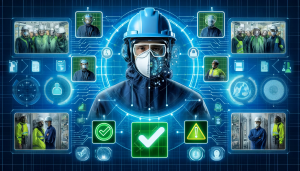 UseCasesFor.ai
UseCasesFor.ai
Choose Topic
 UseCasesFor.ai
UseCasesFor.ai
AI Use Cases
A collection of over 250 uses for artificial intelligence
A continually updated list exploring how different types of AI are used across various industries and AI disciplines,including generative AI use cases, banking AI use cases, AI use cases in healthcare, AI use cases in government, AI use cases in insurance, and more

Sign up
to receive a PDF containing all the use cases and stay updated with the latest AI trends and news (you can always unsubscribe)
Monitoring personal protective equipment (PPE) compliance through image recognition

Introduction
The healthcare sector has been one of the most progressive fields in the adoption of technology in a bid to enhance the quality of patient care and protection. The industry has continued to embrace the use of Computer Vision (CV) Artificial Intelligence (AI) to supplement the monitoring of Personal Protective Equipment (PPE) compliance through the use of images. This has come in handy especially during the current COVID-19 era where the issue of PPEs’ utilization is a critical factor in preventing the spread of the virus and safeguarding the lives of the healthcare workers. CV AI is the ability of a machine to assess images from CCTV cameras and determine if the healthcare workers are wearing their PPEs appropriately.
Challenges
The implementation and application of CV AI in the monitoring of PPE compliance is not without its problems. First, the image recognition can be influenced by bad lighting, low quality images and different angles. Second, there are issues of privacy since CCTV footage is used in monitoring, which involves taking and saving pictures of people. Third, the technology is very powerful in that it needs a lot of computational resources for image analysis especially when dealing with large amounts of image data. Fourth, this may be because it is challenging to achieve real time monitoring since a certain amount of time is needed for image processing and analysis. Lastly, the technology needs to be trained to identify a vast variety of PPE which may be challenging because of the different forms, designs, and colors of PPE.
AI Solutions
There are however several challenges that one is likely to encounter in the implementation of AI solutions in solving the identified problems. There are companies such as DarwinAI and Landing AI that have created CV AI models that are capable of identifying PPE in low light conditions or at odd angles. These models employ the machine learning approach whereby the various looks of PPE is learned from a number of images. To overcome privacy issues, some of the solutions employ edge computing so that the images are processed at the CCTV device level without sending the images or storing them at any other location. This is made possible by the use of GPUs for image analysis thus enabling real-time monitoring. Also, the models are updated frequently with new images to enhance their capability of being able to identify a broader range of PPE.
Benefits
There are huge advantages of using CV AI for PPE compliance monitoring. Firstly, it is a reliable, non-invasive and consistent way of making sure that healthcare workers are using PPE appropriately. This also assists in minimizing the risk of getting infected and enhances the safety of the healthcare workers and the patients. Secondly, it enables the monitoring process to be continuous, this is because manual checks can only be done from time to time. Thirdly, it is an audit of compliance and this can be useful for training or in the event of an outbreak. Lastly, it can help to free up time and resources that would otherwise be used for manual observation.
Return on Investment
From the ROI perspective, the application of CV AI for PPE compliance monitoring can be very beneficial as it may reduce costs significantly. These costs can be reduced due to decrease in number of infections and the costs of treating them as well as reduction in the time and effort that is required for the monitoring process. For instance, a research done by the National Institute for Occupational Safety and Health (NIOSH) revealed that healthcare organizations can cut costs by $3,000 per worker each year if they are able to reduce occupational infections with the help of appropriate PPE.